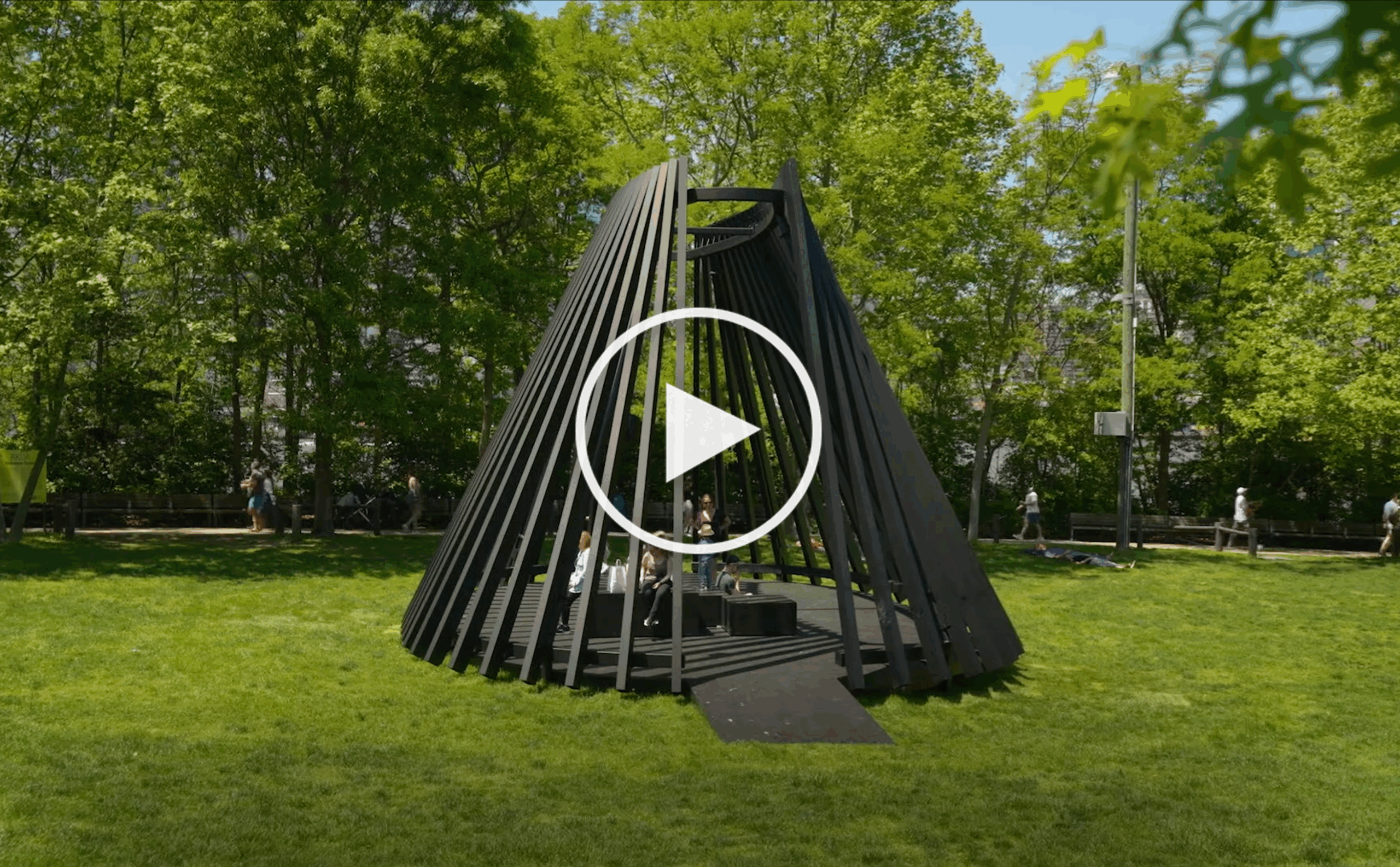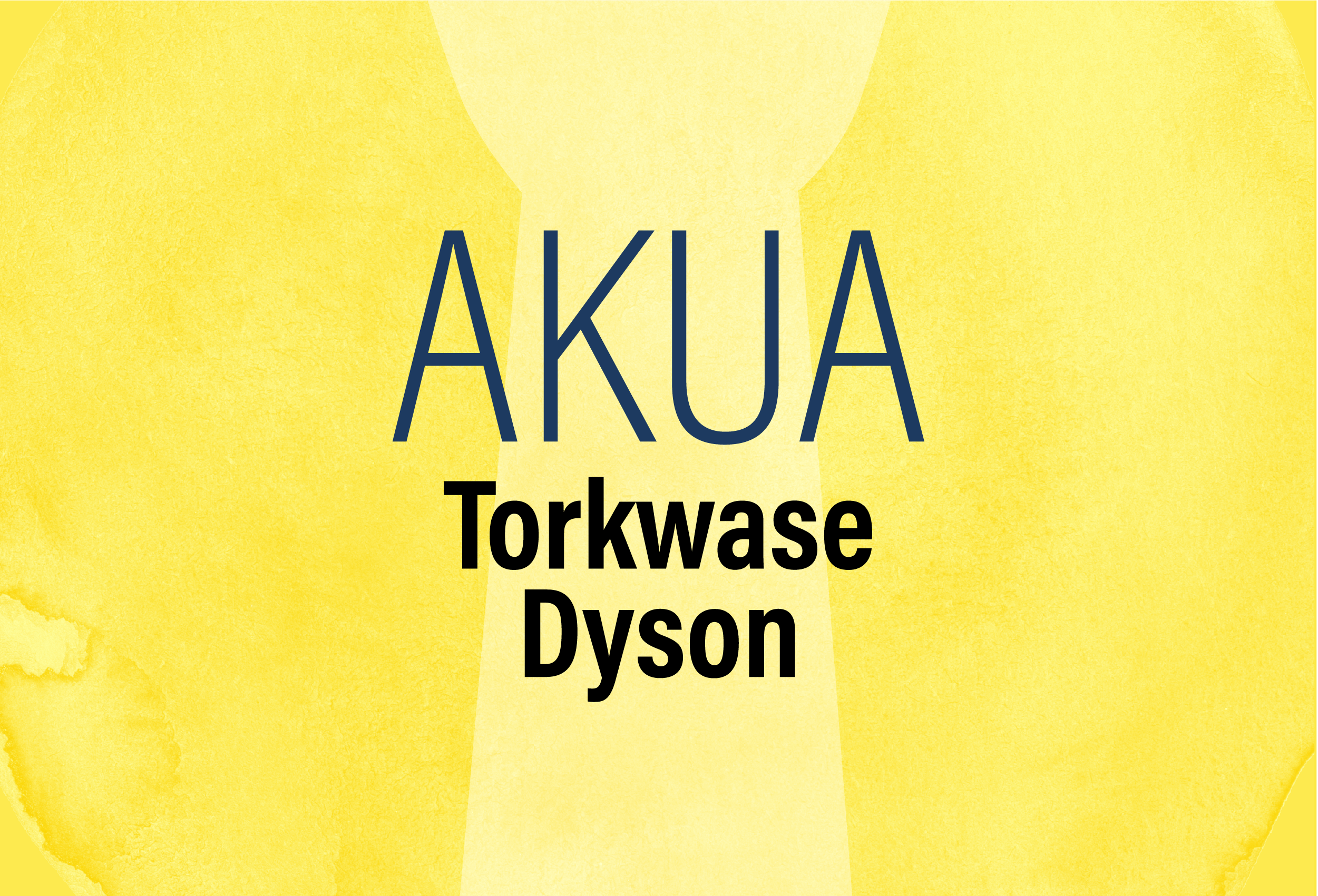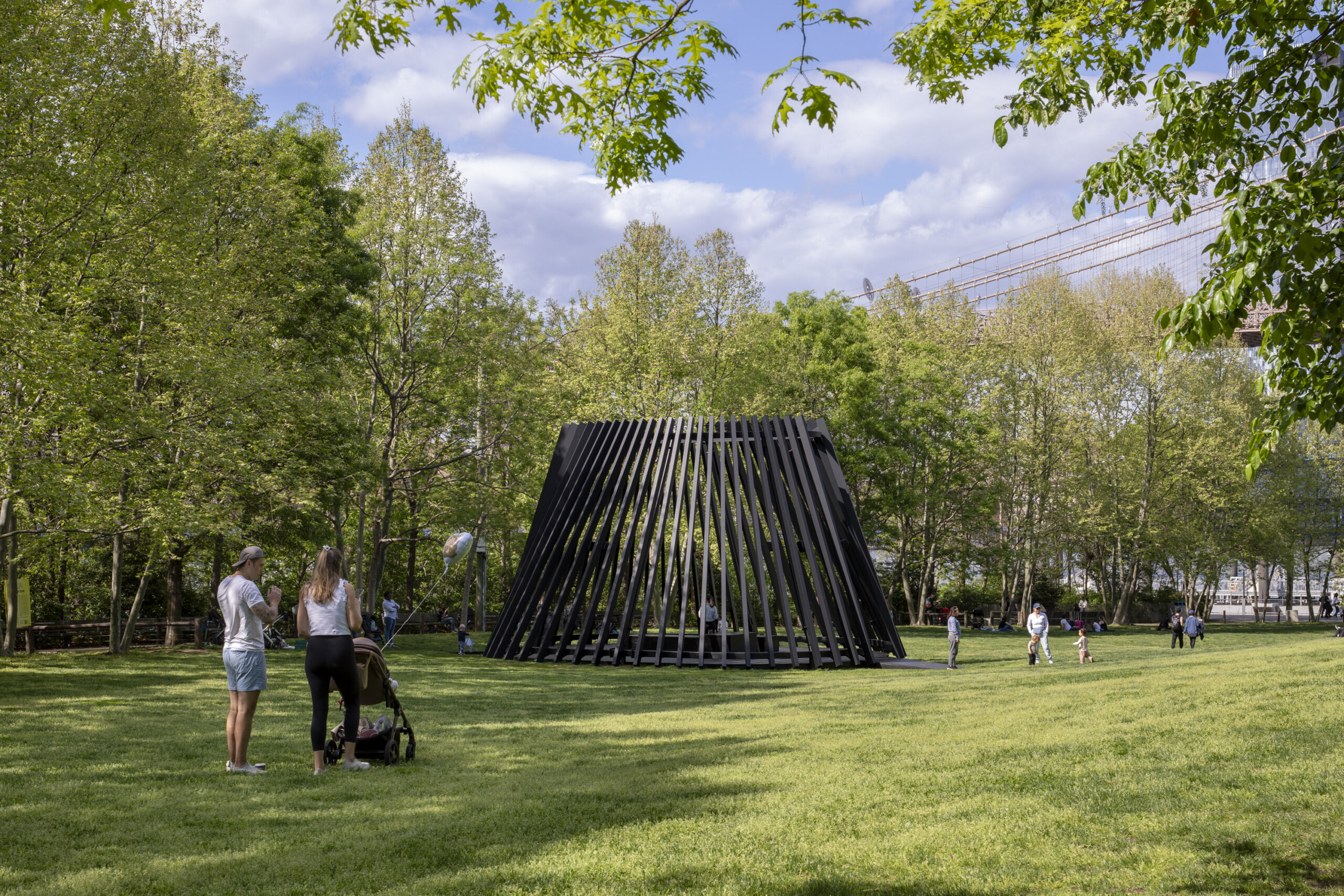Torkwase Dyson’s Akua is a large, open pavilion with an immersive multi-channel soundscape. Visitors may enter and experience recorded sounds moving across eight speakers, including layered conversations from Black archives, nature field recordings, and electronic sounds. For Dyson (b. 1973, Chicago), sound is a physical vibration that can connect our bodies to our surroundings. The title Akua is inspired by the name of a family member; Akua means “born on Wednesday” in West African Akan tradition.
Dyson’s multilayered sonic composition explores the idea of “breath as geography.” The artist proposes that the spaces between words — subtle breaths, ums, pauses — can carry memories of specific places. She asks, “what can the space between words and silence tell us about land, water, infrastructure, and migration?” Surrounded by grand waterways and architectural landmarks, Akua invites audiences into a space of contemplation and imagination, grounded in the landscape beneath and encircling us.
Torkwase Dyson: Akua is curated by Public Art Fund Senior Curator Melanie Kress with Assistant Curator Jenée-Daria Strand.
About the Artist
Torkwase Dyson describes herself as a painter working across multiple mediums to explore the continuity between ecology, infrastructure, and architecture. She frequently creates compositions of three “hypershapes”—a rectangular box, a triangle, and a trapezoid. Each form references a historical person who escaped confinement through a space of that shape: for example, Harriet Jacobs, who spent seven years in a trapezoidal attic crawlspace. As representations of spaces used for escape, migration, and transformation, Dyson’s hypershapes embody a Black experience defined by constant shapeshifting and change.
Dyson has been lauded with major outdoor commissions at Desert X, Palm Desert, California (2023); Counterpublic in St. Louis, Missouri (2023); and the Whitney Museum of American Art as part of the Whitney Biennial 2024.
Dyson studied Sociology, Social Work, and Fine Arts at Tougaloo College in Mississippi, and received a BFA from Virginia Commonwealth University in Richmond in 1999 and an MFA from the Yale School of Art in New Haven, CT, in 2003. She has held one-artist exhibitions at Graham Foundation, Chicago (2018); The Drawing Center, New York (2018); New Orleans Museum of Art, Louisiana (2020); Serpentine Pavilion, Serpentine Galleries, London (2021); Hall Art Foundation, Schloss Derneburg, Germany (2021); Mildred Lane Kemper Art Museum, St. Louis, Missouri (2023); and ‘T’ Space, Rhinebeck, NY (2023); among others. Dyson was also part of the 13th Shanghai Biennale (2021); 12th Liverpool Biennial, England (2023); 12th Seoul Mediacity Biennale, Seoul Museum of Art (2023); and the Whitney Biennial 2024, Whitney Museum of American Art, New York City. Dyson will create the conceptual design for Superfine: Tailoring Black Style, the Costume Institute’s Spring 2025 exhibition at The Metropolitan Museum of Art, New York City.
Dyson’s work is held in notable public collections including the Art Institute of Chicago; Hall Art Foundation, Reading, VT; Hammer Museum, Los Angeles; Hirshhorn Museum and Sculpture Garden, Smithsonian Institution, Washington, DC; Long Museum, Shanghai; National Museum of African Art, Smithsonian Institution, Washington, DC; Mead Art Museum, Amherst College, MA; Mildred Lane Kemper Art Museum, St. Louis; and Studio Museum in Harlem, New York City, among others.
Installation Photos
Location
Videos
Related Programs
Akua de Torkwase Dyson es un gran pabellón abierto con un paisaje sonoro envolvente de múltiples canales. Los visitantes pueden entrar y escuchar sonidos grabados desplazarse a través de ocho bocinas, incluyendo conversaciones de archivo que se superponen entre personas negras, grabaciones de campo en la naturaleza y sonidos electrónicos. Para Dyson (n. 1973, Chicago), el sonido es una vibración física que puede conectar nuestro cuerpo con nuestro entorno. El título Akua está inspirado en el nombre de un miembro de su familia. Akua significa “nacido en miércoles” en la tradición Akan de África occidental.
La composición sonora en distintas capas de Dyson explora la idea del “aliento como geografía”. La artista propone que los espacios entre palabras (respiraciones sutiles, ums y pausas) pueden transmitir recuerdos de lugares específicos. Se pregunta, “¿qué nos puede decir el espacio entre las palabras y el silencio sobre la tierra, el agua, la infraestructura y la migración?” Rodeada de grandes vías fluviales y monumentos arquitectónicos, Akua invita al público a un espacio de contemplación e imaginación, arraigado en el paisaje que está debajo y que nos rodea.
Torkwase Dyson: Akua es de la curaduría de Melanie Kress, curadora de Public Art Fund, junto con Jenée-Daria Strand, asistente curatorial.
Acerca de la artista
Torkwase Dyson se describe como una pintora que trabaja con múltiples medios para explorar la continuidad entre la ecología, la infraestructura y la arquitectura. Con frecuencia crea composiciones de tres “hiperformas”: una caja rectangular, un triángulo y un trapezoide. Cada forma hace referencia a un personaje histórico que escapó del confinamiento a través de un espacio con esa forma como por ejemplo Harriet Jacobs, quien pasó siete años en un ático trapezoidal. Como representaciones de espacios utilizados para escapar, migrar o transformarse, las hiperformas de Dyson encarnan una experiencia negra definida por la mutación y el cambio constantes.
Dyson ha sido celebrada con grandes comisiones al aire libre en Desert X, Palm Desert, California (2023); Counterpublic en St Louis, Missouri (2023); y en el Whitney Museum of American Art como parte de la Bienal del Whitney del 2024.
Dyson estudió Sociología, Trabajo Social y Bellas Artes en Tougaloo College en Mississippi, y recibió una Licenciatura en Bellas Artes de Virginia Commonwealth University en Richmond, Virginia, en 1999 y una Maestría en Bellas Artes de Yale School of Art en New Haven, Connecticut, en 2003. Ha realizado exposiciones individuales en la Graham Foundation, Chicago (2018); The Drawing Center, Nueva York (2018); New Orleans Museum of Art, Luisiana (2020); Serpentine Pavilion, Serpentine Galleries, Londres (2021); Hall Art Foundation, Schloss Derneburg, Alemania (2021); Mildred Lane Kemper Art Museum, St. Louis, Missouri (2023); y ‘T’ Space, Rhinebeck, Nueva York (2023); entre otros. Dyson también formó parte de la 13ª Bienal de Shanghái (2021); 12ª Bienal de Liverpool, Inglaterra (2023); 12.ª Bienal de Mediacity de Seúl, Seoul Museum of Art (2023); y la 81.ª Bienal del Whitney, Whitney Museum of American Art, Nueva York (2024). Dyson creará el diseño conceptual de Superfine: Tailoring Black Style, la exposición de primavera de 2025 del Costume Institute del Metropolitan Museum de Nueva York.
La obra de Dyson forma parte de importantes colecciones públicas, entre ellas, The Art Institute of Chicago; Hall Art Foundation, Reading, Vermont; Hammer Museum, University of California, Los Ángeles; Hirshhorn Museum and Sculpture Garden, Smithsonian Institution, Washington, D.C.; Long Museum, Shanghai; National Museum of African Art, Smithsonian Institution, Washington, D.C.; Mead Art Museum, Amherst College, Massachusetts; Mildred Lane Kemper Art Museum, St. Louis, Missouri; y The Studio Museum in Harlem, Nueva York, entre otros.
 Menu
Menu







